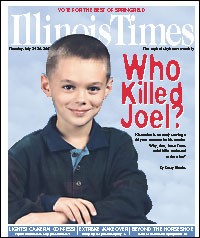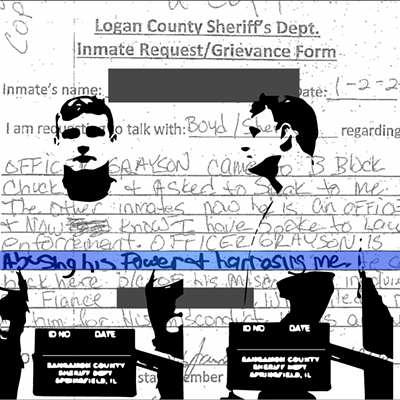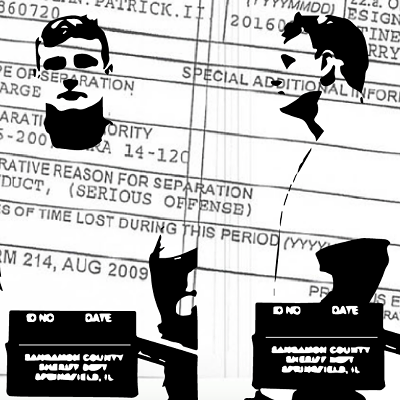Julie Rea has told this story hundreds of times. But no matter how many times she tells it, the story never makes sense.
She was asleep in her own bed when she heard a child scream. This child sounded more terrified than her son Joel ever did, no matter what kind of nightmare engulfed him.
She slipped out of bed and padded across the hall into the 10-year-old's room. The light from the hallway illuminated his bed enough that Julie could see it was empty. She called out his name.
"Joel? Joel?"
Suddenly someone bounded over the bed and brushed past Julie. Was it Joel? Wearing a mask? Why wouldn't he stop? He was desperate to get away from her, to escape. Julie chased him down the hall, past the living room, through the kitchen. He broke through a glass door leading into the garage. "You shouldn't do that, it's dangerous," Julie thought, as he crashed through a second glass door into the back yard.
He turned and started swatting Julie, trying to shoo her away. He was strong and wild-eyed. He definitely wasn't Joel.
They scuffled briefly--she remembers grabbing his legs, his arm around her neck, her face on the ground. She was surprised at how hard he was hitting her. Then he was off, walking toward the woods, pausing briefly to remove his mask. She caught a glimpse of his profile, then she ran the opposite way, toward the nearest neighbor with lights on. "Joel's gone! Joel's gone!" she yelled, pounding on the door. The neighbors called police and reported the kidnapping.
After what felt like forever, police and paramedics arrived. The police went to Julie's house while a paramedic bandaged her arm. Then an officer came and said someone else needed medical attention.
It was Joel. He had not been kidnapped; he had been killed. His body was found on the floor between his bed and the wall. Joel Kirkpatrick had been stabbed to death in his own room, his own bed, apparently with a steak knife from his own mother's kitchen.
In the days and weeks and months to come, investigators found no sign of forced entry into Julie's house, nothing stolen, no fingerprints, and no one with any motive to kill a 10-year-old boy who was by all accounts exceptionally sweet, considerate, and bright.
Julie tried to move on with her life. She left Lawrenceville, the little town where her son was murdered, and rented a duplex in nearby Bloomington, where she continued her studies toward a PhD in educational psychology. To deal with her constant overwhelming fear, she installed security lights outside the duplex, planted thorn bushes under every window, and bought a German shepherd named Nosyt, already trained as a personal protection dog. More than a year after Joel's murder, she went out on a blind date. She and Mark Harper fell in love and got married.
But while Julie lived in fear that the killer would return for her, law enforcement officials in Lawrenceville zeroed in on Julie. On October 12, 2000--three years almost to the day after Joel died--a special grand jury indicted Julie for murder. After a two-week trial at which she was represented by an overworked public defender, Julie was found guilty and sentenced to 65 years in prison.
The prosecutor, Ed Parkinson, later told reporters that Julie was convicted by "her ridiculous story"--the one that never made any sense. In an interview broadcast on the TV show 20/20, Parkinson said, "To believe her, you would have to believe that this assailant came into her home in the middle of the night in dark clothes, hiding his identity by the use of a mask, for the sole purpose of killing a 10-year-old boy. And after he accomplished his result, he pulled off the mask to reveal his identity to her. Nonsense."
He dismissed the notion that someone else could have committed the crime: "No one in this world except Julie Rea fits the killer."
Watching that 20/20 episode, aired May 31, 2002, Diane Fanning reached a different conclusion. In a letter to a man who had become her pen pal, Fanning mentioned the TV segment about the imprisoned mom and opined that the woman might be innocent. "You listen to the law enforcement guys and the prosecuting attorney and they are so full of stupid opinions," Fanning wrote.
Her irreverent tone was meant to humor her pen pal, a serial killer named Tommy Lynn Sells, imprisoned on Texas' Death Row. Fanning, who lives in New Braunfels, Texas, was in the process of writing a book about Sells, and she needed to stay on good terms with her subject. "He'd get irritated if I didn't write back immediately," she says. "I'd write two [letters] for every three he wrote to me."
His last dispatch had been full of complaints about Texas Rangers (the law enforcement agency, not the baseball team). He didn't appreciate the way they were pressing him for details about a murder he had confessed to committing.
"I was writing to tell him to cut them a little slack, because they encounter other officers in law enforcement that they have to prove things to," Fanning says. "I told him that sometimes those other officers and DAs don't think clearly, and here is an example that I'd just seen on TV."
She went on to outline what she felt were faulty assumptions espoused by the prosecution: No strange fingerprints, no motive, yet such violence that the perpetrator must have had a close relationship to the child. And finally--in what Fanning called "my very favorite on the stupid scale"--the notion that no one intent on murder would enter a strange house and grab a knife from the kitchen.
"After hearing that garbage, I believe it is very possible that woman is telling the truth," Fanning wrote.
Sells, she knew, would agree with her opinion. Still, she was utterly unprepared for his response.
No one knows how many people Tommy Lynn Sells has killed. Sells himself isn't even sure. He has a documented history of mental illness, a penchant for cross-country travel facilitated by auto theft, and a tendency to associate with characters on the fringes of society. Since childhood, he has abused every substance available, from alcohol and inhalants to heroin and LSD. Combine that with his creativity in disposing of bodies and his fastidious flair for leaving crime scenes fingerprint-free, and you have the ingredients for a boundless blur of mayhem.
Sells claims to have committed approximately 50 murders. A handful of those confessions have been proven false. The majority of his avowed crimes may never be proved or disproved because the victims were prostitutes, junkies, or homeless--nameless, faceless people who disappeared without notice.
Johnny Allen, a Texas Ranger who has been investigating Sells since January 2000, says some agencies hear Sells is already on Death Row and see no need to bother tying him to a cold case. "Some of the agencies weren't interested," Allen says. "This has just been a nightmare."
But Allen has no doubt that Sells is a serial killer.
"There are 15 [murders] that I'm confident he's connected to, that we feel reasonably sure he's committed," Allen says. Sells has also been implicated in two attempted murders.
In six of these crimes, a knife was Sells' primary weapon. Five began just as Joel Kirkpatrick's murder did--with victims being stabbed while they slept. Sells was finally caught when one young victim survived by playing dead. He was convicted of killing her roommate.
The earliest murder Texas Rangers attribute to Sells dates back to July 26, 1985, shortly after he turned 21. He was working as a carney at the Taney County Fair in Springfield, Missouri, when he attracted the attention of Ena Cordt. A single mom who attended the fair with her four-year-old son, Willie, Cordt welcomed Sells into her home later that night.
According to the account in Fanning's book, their visit was pleasant until Sells caught Ena rifling through his backpack. Assuming she was trying to steal his stash of cocaine, Sells picked up Willie's baseball bat and began beating Ena, then picked up a kitchen knife and slit her throat. When Willie got out of bed to see what the commotion was, Sells beat the child to death with the bat. Then he wiped everything he had touched to eliminate fingerprints and left taking Willie's baseball bat with him.
In October 1987, Sells drifted through Nevada and worked briefly for a roofing company in the mining town of Winnemucca. There, he met college coed Stefanie Stroh, who was hitchhiking across the country. In his confession, Sells said he offered her a ride to Reno, but along the way they pulled off the road to drop acid together. Sells choked the 20-year-old girl to death. Then, noticing a washtub and a bag of cement mix in the bed of the stolen truck he was driving, he anchored the girl's feet in the tub, waited overnight for the concrete to harden, and dumped her body into a nearby hot spring the next morning.
A month later, he was across the country in the tiny town of Ina, near Rend Lake in southern Illinois. At the edge of town, he staked out a trailer, home to Keith and Eileen Dardeen and their young son Peter. The Dardeens had a "for sale" sign on the trailer; they were expecting a new baby and hoping to move to a bigger house. Using the sign as an excuse to strike up a conversation and a stolen gun to force his way inside, Sells bullied Keith Dardeen into providing duct tape so he could bind Eileen and Peter.
Sells forced Keith to drive him about a mile away, then shot and sexually mutilated the young father. Sells then drove Dardeen's car back to the mobile home, where he raped Eileen and attacked little Peter with the child's own baseball bat. When Eileen tried to protect her son, Sells attacked her with the bat. The trauma sent Eileen into labor. Sells waited until the premature baby emerged, beat it to death and then killed Eileen. He cleaned up after himself--removing the duct tape, wiping away any fingerprints, and leaving the family car parked near a police station.
Years later, when he confessed to the Texas Rangers, he remembered enough minute details to persuade skeptics of his guilt. One item that he recalled was a Toucan Sam hat hanging on a coat rack in the Dardeen home.
Sells crossed the country again and landed in Utah, where, a few months later, he claims to have killed a homeless woman and her son. Authorities have confirmed that in December 1988, in Tucson, he killed a homeless man by stabbing him to death in his sleep, revenge for the man's failure to pay for a bag of marijuana.
Several years and several unconfirmed killings later, Sells had a life-changing experience. Posing as a homeless person needing help for his family, he wormed his way into the West Virginia home of a 20-year-old good Samaritan named Fabienne Witherspoon. As she filled bags with food and clothes to send to his wife and kids, Sells chose a knife from her kitchen to impel her to submit to his sexual assault.
But Witherspoon found an opportunity to fight back. Bent over a bathroom fixture, she picked up a ceramic duck, bashed it into Sells' head, and gained control of the knife. She did enough damage that Sells spent a week in the hospital before a plea bargain sent him to prison for five years.
Both Fanning and Allen have spent the past few years debriefing Sells, and they both notice a change in his modus operandi after this encounter.
"He had five years to think about the lesson to be learned," Fanning says. "After he got out, every victim was age 16 or under."
He was released in May 1997. Joel Kirkpatrick was killed five months later.
One of the few things Joel's friends and relatives agree on is the fact that he was an exceptional child.
Rick Mitchell, a former boyfriend who has remained friends with Julie, played computer games with Joel. "He had a way of relating to adults that was unusual for a child his age," Mitchell says.
Jane Rea, Julie's mom, remembers one of Joel's teachers saying she enjoyed having him in class because he "got" her jokes. Another teacher, Jane says, still keeps Joel's IQ test in a file, because it's so rare to have a student score higher than 150.
Jim Rea, Julie's father, describes Joel as "quiet, as kids go," but well-liked. "He was the kindest, lovingest, most brilliant little boy I think I have ever been around," Jim says. "He was always very solicitous toward everyone around him. He wanted everybody to be happy."
Len Kirkpatrick--Joel's father and Julie's first husband--says no one could ask for a better child. "Joel was special and dear beyond compare," Len says. "He was a kind soul--you wouldn't find a kinder one--and empathetic, diligent, smart, made straight As, uncomplaining about homework or any household chore he may have been asked to do. He was just the finest individual I've ever known, and I'm proud to have had the precious time I had with him."
Past that oasis of unanimity, though, is a vast desert of mutual resentment, suspicion, and hostility. The two sides talk about each other, but never to each other. For the past 10 years, Len and his parents have not spoken to Julie and her parents.
The feud between the former in-laws is made even more painful by the closeness they once shared. As Free Methodist missionaries to central Africa, they were working together when Len and Julie were born. The Reas returned to the U.S. when Julie was a toddler; the Kirkpatricks made a trip stateside every few years. During one of these visits, Len and Julie fell in love. They got married at the ages of 18 and 17, respectively. Joel was born 11 months later.
But the marriage eventually disintegrated, despite more than a year of counseling. When Joel was six, Julie took him and left. The divorce was finalized in September 1994. Len remarried the following May. His ability to offer a two-parent home may have been a deciding factor in the custody dispute. They shared joint custody, but just before school started in the fall of 1997 Len was given "residential custody," a decision Julie had unsuccessfully appealed.
The timing of Joel's death on the heels of such a fierce custody conflict commingled the emotions of the two events and cemented the hard feelings between Julie and Len and their extended families. Indeed, some say the conflict provided the motive for Julie to kill her son. Could she have decided--If I can't have Joel, Len can't have him either? Len and the prosecution team believe this scenario; Julie's parents and friends find it preposterous.
The logic of this theory is purely relative: There's no such thing as a rational reason to kill a slumbering child. If Illinois State Police investigators assigned to the case had discovered a more reasonable scenario, they surely would have explored it.
They did chase down several leads. In the weeks following the murder, a rumor circulated that one or more teenage boys left a nearby party and broke into Julie's house to steal her VCR. The boy or boys, high on methamphetamines, "freaked out" when Joel interrupted the burglary and stabbed him. According to some versions, they returned to the party wearing bloody clothes after burying the murder weapon under the floor of a shed. Investigators lost interest in this theory because the rumor had Joel being stabbed to death on the couch (instead of in his bed), and the specified shed had a gravel floor that appeared to have nothing buried beneath it.
The absence of other viable suspects soon focused the investigation on Julie.
Any experienced investigator will tell you the usual perpetrator of violence against a child is a parent. So it's not surprising that Joel's parents came under scrutiny.
Len Kirkpatrick, though, was quickly cleared. His wife said he was asleep in bed at the time of the murder, and an officer sent to his home in Charleston, near Mattoon, confirmed his car was sitting cold in the driveway. Besides, even Julie said the intruder she scuffled with was not Len.
But Julie had no alibi. All she had was her story--the one that made no sense.
Some evidence bolsters her account: Her nightshirt was not covered in Joel's blood, as it should have been if she had stabbed the child. At her trial, the prosecution's forensics expert testified that the only bit of Joel's blood on Julie's shirt was a "transfer" smear from brushing up against something, not a direct spatter. Other blood spots on her shirt turned out to be her own blood, which had oozed from an inch-deep cut on her arm that required five stitches to close (curiously, this wound was never photographed).
Julie also had a black eye, bruising on her shoulders, and superficial abrasions on her legs and the tops of her feet. Her shirt had grass stains on the back. And finally a bloody shoe print found on glass matched the footwear of no one at the crime scene.
Prosecutor Ed Parkinson, however, argued this scene was staged, and Len Kirkpatrick agrees. If Julie had actually struggled with an intruder, Len says, the house would have been in disarray. Framed prints would have been knocked ajar on the walls. Chairs would have been bumped, papers knocked askew. The house would have looked like a fight took place, he says.
Investigators conducted four interviews with Julie, and say her story changed, decreasing the amount of struggle in the house. However, Julie's friends and parents say her description never varied; she always described more of a chase than a struggle inside the house. Police recorded only one of their interviews--the third one, in which she describes a chase.
Len has his own theory. "I truthfully feel like she had an accomplice in the cleanup or cover-up," Len says, "and I believe that person to be her father or possibly her mother."
Jim and Jane Rea have heard Len's theory before and, not surprisingly, deny participating in any cover-up. Police examined the plumbing in Julie's house and found all the drains dry. They even dug up the septic tank and sifted through its contents and found no bloody residue.
All this effort to find evidence of Julie's guilt stands in contrast, Julie's friends say, to the lack of effort to find evidence that could exonerate her.
"There's no evidence of an intruder because they never looked for one," says Rick Mitchell, a friend of the family who once was Julie's boyfriend.
A month after the murder, state police had what they admit was a "confrontational" interview with Julie Rea, grilling her about inconsistencies in her story and telling her they had evidence of her hair in Joel's wounds and satellite photos that proved no struggle took place in her backyard. They later said these "white lies" were tossed out just to "see how she would react." She hired a lawyer and quit cooperating with their investigation.
Both Len and Julie took two polygraph exams. Len passed the crucial question--"Did you kill Joel?"--on the second test. But the examiner described Len's answers to other questions--"Did you plan or arrange with anyone to kill Joel?" and "Did you plan or arrange with anyone to break into Julie's house last October?"--as "erratic and inconsistent" enough that the test was inconclusive.
Julie passed two polygraphs given by two different examiners, but Len points out they weren't administered by Illinois State Police, as his were.
Julie's family has accumulated a long list of inconsistencies they believe suggests Joel was killed by someone related to Len. But the animosity between the two families is so explosive, the Reas are reluctant to talk openly for the record.
The catalog of claims and accusations collected by each side of Joel's family against the other is endlessly and tragically exhaustive. Perhaps such a reaction is inevitable--a desperate attempt to make sense of a truly senseless crime.
The letter Diane Fanning wrote to Tommy Lynn Sells about the 20/20 segment on Joel's murder did not mention any name, date, or location, just a vague description:
"The other night, I was watching a story on TV about a woman who was in jail for killing her son. She claims someone broke into her house and killed him. You could say, 'Yeah right, lady. We've heard that story before.' But then you listen to the law enforcement guys and the prosecuting attorney and they are so full of stupid opinions. . . . "
Fanning, who had spent enough time with Sells and the Texas Rangers to believe serial killers aren't just characters in horror films, was inclined to believe Julie's story. "When I saw the show on 20/20, my thought was that it's an intruder crime," she says. "My thought was that someone like Tommy Lynn Sells did it. I wasn't thinking it could be him. I was extremely shocked when he responded to me the way he did."
He answered her letter with a couple of questions: "About that woman claims someone broke into her house? Was that like maybe two days before my Springfield, MO murder? Maybe on the 13th?"
Authorities have confirmed that on October 15, 1997, Sells abducted 13-year-old Stephanie Mahaney from her bed without waking two other children sleeping in the apartment. According to Fanning's book, he took the girl into the countryside, injected her with a large dose of cocaine, raped and strangled her, then dumped her corpse into a nearby pond.
Back up two days before that, to October 13, 1997, and yes, Joel Kirkpatrick was murdered in the early hours of that morning. Sells says he wore not a mask, as Julie described, but a sweatshirt with the drawstring of the hood pulled tightly around his face. As for a motive, he offers little other than an encounter with Julie in a convenience store where, he said, she was rude to him.
"A murder don't always have to do with sex or any of the norms y'all may want to label me with," he wrote in a subsequent letter to Fanning. "Maybe, someone just pissed me off and I did not want their child to be like them. That's cold, I understand. Maybe more than just one person is in jail for the same thing."
No one knows what to make of this confession. Fanning says Sells had no access to a television, no way to hear anything about the 20/20 segment, and no reason to confess. "Somebody said that this confession was just trying to buy time for himself on Death Row. But he confessed this to me more than a year ago. I have not made a big deal about it," Fanning says. "I did not have enough information to make any difference. It was just another story to me." Her book, Through the Window, was published in April by St. Martin's Press.
Julie's husband, Mark Harper, is afraid to get his hopes up, but he says the idea of her being rude to a stranger at a convenience store "really clicked."
"If Julie knows you, she's the kindest, warmest person," he says. "If she doesn't, she keeps you at a distance, particularly if he saw her with Joel and he tried to flirt with her, she would've been rather tart with him."
Yet he has asked Julie whether she recalls such an encounter, and, he says, she could not think of one.
Len Kirkpatrick, who hasn't read Fanning's book, does not believe it. He says her position as executive director of a Texas fund-raiser for nonprofits proves she is biased because the group's 44 members include the ACLU and gun-safety and anti-death-penalty advocates. "Her agenda is definitely slanted," he says. "To me, it's the only son I will ever have and she's cheapening his memory."
Parkinson likewise hasn't read Through the Window--"I usually don't read bad fiction," he quips--but says he will. Meanwhile, he remains "very convinced" that Julie Rea killed her son. "The jury didn't take very long to find her guilty," he says.
Texas Ranger Johnny Allen says he doesn't have enough information to speculate on whether Sells' confession is valid. Sells, who has stopped cooperating with the Rangers, never discussed this crime, and Allen thinks he knows why. "Toward the end, there was a pattern developing in which he attacked younger children, in the 10 to13 year old range, and that seemed to bother him more than discussing murder of an adult," he says.
But he hopes authorities in Illinois will give it serious consideration. "I find it a little alarming simply because we can put him within an hour and a half drive of that murder in that particular time frame," Allen says. "Knowing what he's capable of doing, it just, I hope it's something they would be able to pursue on that end."
Sells' confession and Julie's story do not match perfectly. Sells told Fanning he gained access to Julie's home by breaking a window, but Julie said windows were broken as she chased the intruder out of the house. She believed the intruder was 14 to 17 years old, and Sells would have been 33 at the time.
She also described the intruder as having a shoulder height that "wasn't very much higher or shorter than mine." A check of Texas and Illinois prisoner data sheets shows that both Julie Rea and Tommy Lynn Sells are 5'9".
The Downstate Illinois Innocence Project, based at University of Illinois Springfield, has recently taken on Julie Rea's case. Alva Busch, the former Illinois State Police crime scene investigator who now works for the Innocence Project, says he has not had time to look at the voluminous files in Julie's case, but that he will likely know something as soon as he does.
"I don't like wasting my time," he says.
At a hearing scheduled for late August, Julie's attorneys plan to seek DNA testing of a strand of hair that was found in Joel Kirkpatrick's hand.
"That's fine," Len Kirkpatrick says. "It probably will indeed much to their chagrin come back to be Julie's hair. I certainly don't think it will be Tommy Lynn Sells' hair, because I don't think he was ever in that house."





















